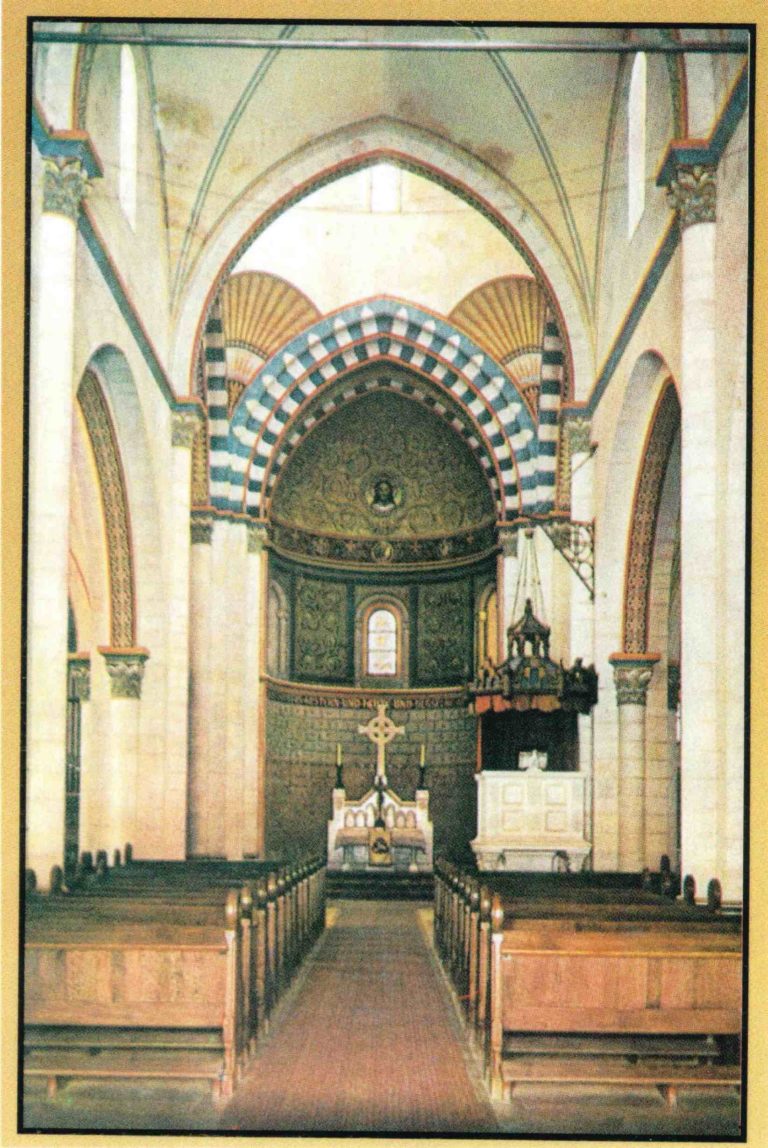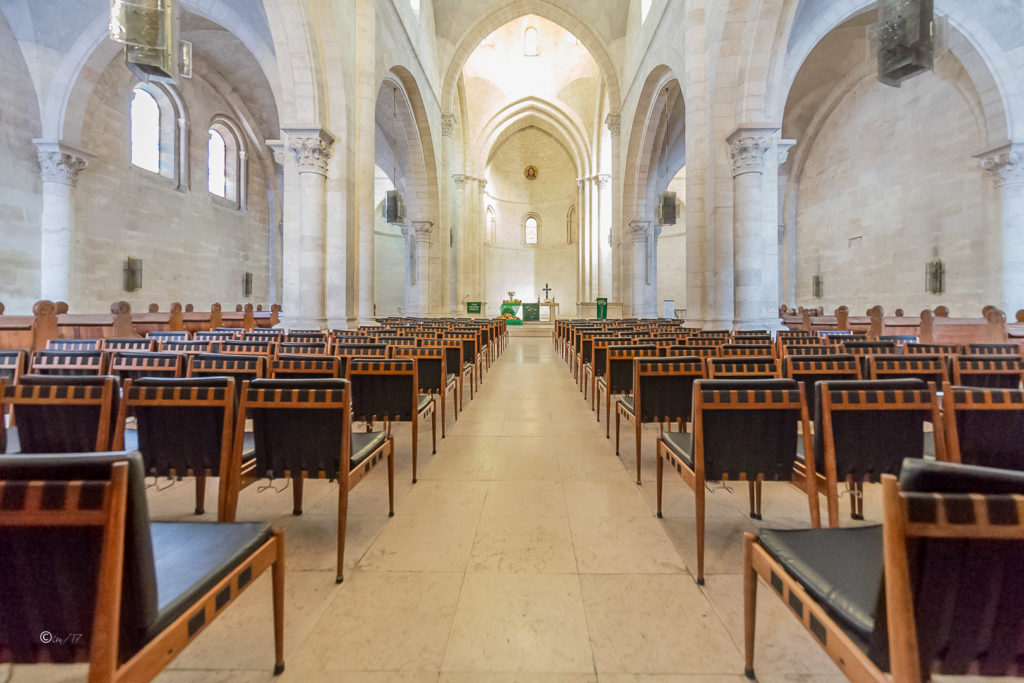Lutheran Church of the Redeemer
Legend has it that Caliph Harun al-Rashid gave Charlemagne the land on which the Lutheran Church of the Redeemer now stands as a gift at the beginning of the 9th century. In 1064, the land became the property of a merchant from Amalfi, who built the church of St. Maria Latina on the site together with a monastery. The monastery was established in 1099 (i.e. in the early years of the Crusades) by the Knights Hospitaller, who were also known as the Order of St. John; their task was to provide care and nursing for pilgrims. After Saladin reconquered Jerusalem and forced the Crusaders to leave, the buildings were neglected for centuries and gradually fell into decay. However, the revivalist movements of the 19th century saw European Christians develop a new and far-reaching interest in the Holy Land. In 1869, Crown Prince Friedrich Wilhelm (as Kaiser Wilhelm II was then known) accordingly took possession of the eastern part of the old Muristan for Prussia. As early as 1871, the Chapel of St. John on the first floor of the cloister (formerly probably the refectory used by the Benedictine monks who once inhabited the building) was restored and used for German-language church services. At the same time, Berlin-based architect and architectural historian Friedrich Adler was commissioned to build the Church of the Redeemer on the site of the former Romanesque church of Santa Maria Latina. The foundation stone was laid in 1893.
The church itself was dedicated on Reformation Day, 31 October 1898, in the presence of the German Kaiser and his wife.
Location
The Lutheran Church of the Redeemer is located in the district known as the Muristan. The name comes from the Persian word “bimaristan” (hospital) and recalls the hospital that the Muslims ran here following the expulsion of the Crusaders. The Church of the Redeemer is only about one hundred metres away from the Church of the Holy Sepulchre. At the beginning of the Common Era, this was one of the highest places in the city.
The land surrounding the modern-day Church of the Redeemer became Prussian property in 1869. Initially, the plan was to rebuild the 12th century Crusaders’ church of St. Maria Latina, the ruins of which were still standing. However, following the first excavations and investigations of the site, the decision was made to build a completely new church – the present-day Lutheran Church of the Redeemer.
The Church of the Redeemer was built between 1893 and 1898 to a design by architect Friedrich Adler. It is located exactly two metres above its predecessor, which was built during the Crusades. It was dedicated on Reformation Day 1898 in the presence of the German Kaiser Wilhelm II and his wife Kaiserin Auguste Victoria.
Church interior
The church’s present-day furnishings were installed as part of the renovation work that took place between 1970 and 1974. The original interior of the Wilhelmine church underwent radical changes during the course of the renovations. The altar and pulpit were removed, as were all the paintings and mosaics on the walls and in the dome. Nowadays, a mosaic of Christ and the windows in the central apse are the only reminders of the church's former design.
The baptismal font now stands under the apse of the north aisle; a processional cross created for the church by artist Hubertus von Pilgrim was erected behind it in 1998. The icon in the apse of the south aisle was written by Benedictine nuns from the Mount of Olives for the Jerusalem Ecumenical Church Day in 1991. It is a reminder of the story of Noah and shows Christ in the Father’s image as He sets his rainbow in the sky as a sign of peace.
Today, the neo-Romanesque church is the centre of the German, Arabic-speaking and other Protestant communities in Jerusalem.



Mosaic of Christ
The only feature to survive the extensive renovation work carried out in the Church of the Redeemer is the mosaic of the head of Christ in the main apse. This mosaic forges a link from Kaiser Wilhelm II all the way back to Emperor Constantine:
before the church was renovated, the design in the main apse was similar to that in the apse of the Lateran Basilica in Rome, which was commissioned by Constantine. A very similar head of Christ is located there.
By building the Church of the Redeemer, Wilhelm II saw himself as perpetuating the tradition of Constantine.
The effect of this beautiful mosaic is such that visitors can stay in eye contact with Christ no matter where they are in the church.
Church windows
The church of 1898 had stained glass windows with ornamental patterns predominantly in red and yellow, as can still be seen in the main apse today.
These windows were badly damaged during the wars of 1948 and 1967, as a result of which new glass windows were installed in 1971.
The new windows were created by Jewish glass painter Anna Andersch-Marcus (1914-2005).
They are installed at three different heights and use abstract shapes and blocks of colour to portray the central theme: “Out of the depths have I cried unto thee, O Lord. Lord, hear my voice” (Psalm 130:1-2) „Aus der Tiefe rufe ich, Herr, zu Dir. Herr, höre meine Stimme“ (Psalm 130,1-2)
Tower and bells
Visitors can climb the tower from the church. The first 177 steps lead up to the belfry.
Inscriptions on the three bells (all made by master bell founder Franz Schilling from Apolda):
From the belfry, another staircase leads up to the highest arcade walkway approx. 40 m above the ground. The bell tower is the only one of its kind at the heart of the Old City. The panoramic view from the top is therefore unique. Right next to the Church of the Redeemer, you see the covered bazaar streets and the residential districts in the Jewish, Christian, Armenian and Muslim Quarters.
To the south, you look past David Street to the Jewish Quarter with the Wailing Wall. The city of David lies beyond the city walls.
To the south-west, you look past the Armenian Quarter to the Dormition Abbey. Further west, the so-called Tower of David stands out against the panorama of the New City.
The “Muristan” is located just west of the Church of the Redeemer in the city’s Christian Quarter. The Franciscan Church of the Saviour dominates the north-west of this quarter.
Just north of the Church of the Redeemer is the Church of the Holy Sepulchre, the holiest place in Christendom. Beyond it to the north-east, you can look over the Arab Quarter with the Austrian Hospice, St. Anne’s Church on the Pool of Bethesda, and the Via Dolorosa.
To the east of the Church of the Redeemer is the former Jewish Temple Mount, now the Haram esh-Sharif, with the Dome of the Rock and the al-Aqsa Mosque. Finally, you can look beyond the Kedron Valley to Mount Scopus with the Hebrew University and to the Mount of Olives with the ascension churches, the Jewish cemetery and the “Auguste Victoria Compound”, which houses our Church of the Ascension, the Auguste Victoria meeting centre with its café, and the German Protestant Institute of Archaeology (GPIA).
Organ
In 1971, organ builder Karl Schuke GmbH, Berlin, built the Church of the Redeemer's organ in the newly constructed west gallery. It replaced the old organ built by Berlin-based company Dinse at the time the church was constructed, to which Weigle from Stuttgart added another 33 stops in 1938. Parts of the housing of this organ, which stood slightly elevated in the left transept, were used to build the organ in the great hall of the University of Haifa.
Another three reed stops were added to the present-day Schuke organ in 1984; it now has 21 stops, two manuals and one pedalboard. The stop and key action are mechanical.
As well as the Schuke organ, the church also has a so-called choir organ. The Church of the Redeemer’s choir organ stands in the north aisle and was built in 1965 by the Wilhelmshaven-based company Alfred Führer. From this time on, it stood in the organ gallery of the Chapel of St. John in the cloister of the Church of the Redeemer. In 2015, it was mobilised and moved into the Church itself. It has been tuned to the same pitch as the Schuke organ.
Exhibition
The exhibition in the medieval cloister consists of a display of artefacts from the history of the Church of the Redeemer and the surrounding residential area, the “Muristan”, and illustrates the questions asked and working methods used by archaeologists. Of particular interest are the finds dating back to the times of Herod the Great, Jesus of Nazareth and the Emperors Hadrian and Constantine. The exhibition also focuses on the history of the medieval “Muristan” and on pilgrim life in those times. The tour “Through the Ages” appropriately ends with the church work now performed by “Evangelical in Jerusalem” and other Protestant communities in the region.
http://www.church-of-the-redeemer-jerusalem.info/ausstellung/index#top
Excavations
Bei den Ausschachtungsarbeiten zur Errichtung der Erlöserkirche kam es 1893 zu einer archäologischen “Sensation”: Bauarbeiter stießen auf eine Mauer, die Gelehrte als die antike Stadtmauer zur Zeit Jesu identifizierten, von der schon der jüdische Geschichtsschreiber Josephus Flavius berichtet. Die sogenannte “Zweite Nordmauer Jerusalems” schien gefunden.
http://www.church-of-the-redeemer-jerusalem.info/ausgrabung/index#top

Mit dem Laden der Karte akzeptieren Sie die Datenschutzerklärung von Google.
Mehr erfahren
Spendenkonto der Evangelischen Gemeinde
deutscher Sprache zu Jerusalem:
IBAN: DE88 5206 0410 0004 1076 32
BIC: GENODEF1EK1
Evangelische Kreditgenossenschaft Hannover